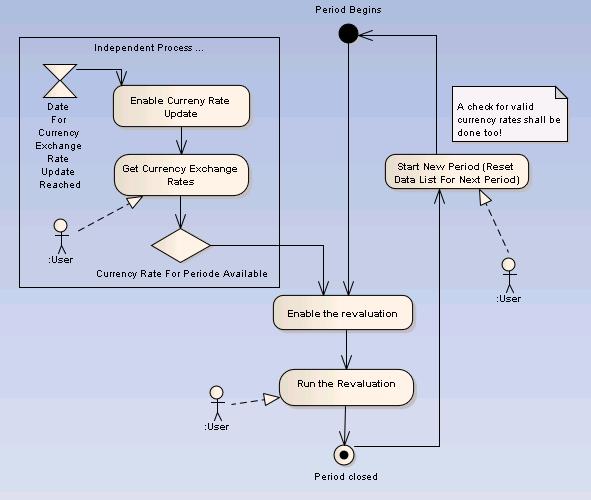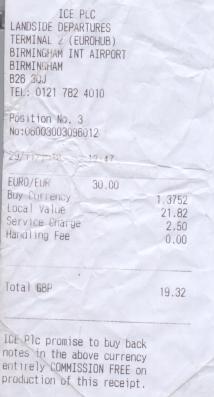Revaluation
Revaluation is a peridical process in the accounting processes if the ledger holds up a set of foreign currency accounts. The standard case for such a period is a month but this can be changed.
In order to understand the revaluation resp. in order to be able to run a revaluation process, you have to unterstand that you need at least 3 processes to be able to run it.
Revaluation outside - the other Processes
The foreign currency update
The first extern process is the update of the currency exchange rates. This process may have the same period as the revaluation process (one month) but in normal cases this process is totally desynchronized. The accounting interval may be an interval in the past and for example the January the 1st 2011 may be the date to define the values which are actual for the following month and the accounting interval may be a month in 2009. So this process is running parallel but on it’s own rules.
The update process can be done more ore less automatically. A set of different techniques are possible.
- It may be possible that one ore more different public information server on the web are good for the job.
- It may be a good idea for the OM-International to offer an update service for all those national offices
- It can be done manually by a user.
In the development phase for the revaluation a static test data set will be sufficient. But you can not use the revaluation without at least one running update processes.
The Period Reset
After all jobs in an accounting period have been done, the accounting period will be closed and the work will be continued using the next period. Such a reset must exist in some rudimentary form.
The Revaluation
There are two reasons for a revaluation.
- A foreigen currency transaction has been accounted and the transaction sheets are out of balance.
- The foreign currency exchange rates changes and this automaticaly disbalances the accounts.
Revaluation situations
A normal transaction
The best way is to get a look onto a voucher I've got by changing some money. I beg your pardon for the bad quality but is was meant to be for private use only. That was no business money.
This voucher tells us: I have changed € 30.00 into £ 21.82. The exchange rate was 1.3752 and there was a fee of £ 2.50. I'm comming form Germany and so let us assume that the base currency of my accounting is €.
Furthermore the exchange rate on the voucher was 1.3752 but the internal exchange rate may be 1.300. So we geht the account list:
For the exchange itself:
- Account 6000 Petty Cash € - Credit: € 30.00
- Account 6001 Petty Cash £ - Debit: £ 21.82
For paying the provision:
- Account 6001 Petty Cash £ - Credit: £ 2.50
- Account 9000 Provisions € - Debit: TransactionValueIn€Of(£ 2.50, Rate=1.300)
Now we have to do a balancing transaction and I realy need an example. Someone who knows, what do to has to complete the list ...
- Account ...
- Account ...
I realy do not understand what do to because I cannot change the values of one of the accounts 6000, 6001 or 9000 because in this cases the values went wrong. Which accounts do I have to change in which way? This is a blocker. Nothing will go on in this part of the software developement untils someone explains me that!
And be shure the values I can find out myself but I have to understand the accounts and their meanings.
Changes of the currency rate(s)
In this case the values of all accounts have to be calculated and then we have to do the following transactions:
- Account ...
- Account ...
Differences of the two types of revaluation
The main difference is: If you account a voucher you already have defined a batch and a journal and you only have to find the correct balancing transactions to be able to post a balanced batch. If you change the rates, then the batch and the journal will be created too.
So in the normal cases
- Accounting revaluation is a menue point (a one click command) for an existing journal which holds foreign currencies
- Ledger revaluation a full automatic process which is to be done inside the “Close accounting period”-process. The exchange rates are stored in the databases and the account values too. Only a revaluation configuration shall be developed.
The Ledger-Revaluation configuration shall handle the following information:
- Select the correct revaluation accounts and cost centers (which are implicitly valid for the accounting revaluation).
- Decide weather the revaluation has to be done as the last action of a period or as the first action.
May be that somewhere in the middle is an option but then someone has to start it manually and independently of the “Closing the actual period” process.

